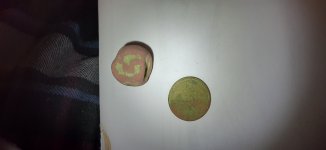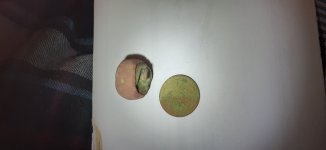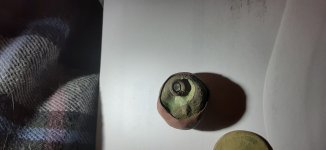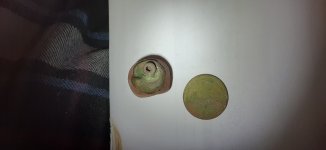Navigation
Install the app
How to install the app on iOS
Follow along with the video below to see how to install our site as a web app on your home screen.
Note: This feature may not be available in some browsers.
More options
You are using an out of date browser. It may not display this or other websites correctly.
You should upgrade or use an alternative browser.
You should upgrade or use an alternative browser.
Can Anyone ID This Button For Me
- Thread starter Tencents
- Start date
Coinstar magnet
Silver Member
- Apr 5, 2020
- 2,789
- 5,802
- Detector(s) used
- Tesoro compadre
- Primary Interest:
- All Treasure Hunting
I'm not an expert but the metal bit with the hole...sorry, I don't know the technical name, tells me it's older...it's an odd looking button....1600's? From my limited knowlege...curious to know if you were detecting in an area where you might find something that old...
Last edited:
villagenut
Gold Member
looks like a zouave button.
Coinstar magnet
Silver Member
- Apr 5, 2020
- 2,789
- 5,802
- Detector(s) used
- Tesoro compadre
- Primary Interest:
- All Treasure Hunting
That would put it in the civil war age range which makes sense if it's a zouave button...I've never heard of a zouave button...

ironhorse
Silver Member
...with no connection to a military or militia unit these buttons are generally and collectively known as ball buttons and are usually found at sites dating from the early to mid 1800s
It's a civil war period dragoon style 3 piece "ball" or "zouave" style button. Used by military and civilians alike, they abound on some 1850-70's sites. That style button first came into use by about 1835. They are always a good find.
devldog
Silver Member
- Mar 9, 2012
- 3,663
- 6,385
- Detector(s) used
- Whites MXT ALL PRO, Minelab Safari
- Primary Interest:
- Relic Hunting
Tencents, if you aren't familiar with the Zouaves, they were soldiers, who stood out because of their lavish uniforms and dress. The Union or Federal Zouaves dressed in red baggy trousers, white gators, or leggings, and most wore ornate vests, and wore a tassled fez for headgear, or a variation of headgear adopted by their particular unit. These uniforms were of foreign design and made these soldiers stand out. Most of the Federal Zouaves consisted of Firemen which had enlisted and became soldiers. Col Elmer Ellsworth was a young and upcoming officer in the Union Army. He formed and trained the New York Fire Zouaves. Col Ellsworth was a personal friend of President Abraham Lincoln and was said to be the first Union officer to be killed in the Civil War after cutting down a Confetrit flag that was flying above an Inn in Alexandria, Virginia. Col Ellsworths personal guard returned fire and killed the Innkeeper who had shot and killed his Col. If you have ever seen this pic. of the soldier who killed the Innkeeper, he is dressed in his Zouave uniform. The Confetrits had Zouaves too, and a number of them were from Louisianna and were known as "Wheats Tigers", or Col. Wheat's Zouves. A lot of these Zouaves were of French and Creole origin. Although not quite as flashy as their Northern counterparts, they too sore the foreign dress uniforms and were known to be very tough and well trained soldiers.
Last edited:
Steve in PA
Gold Member
- Jul 5, 2010
- 9,601
- 14,221
- 🥇 Banner finds
- 4
- Detector(s) used
- Fisher F75, XP Deus, Equinox 600, Fisher 1270
- Primary Interest:
- All Treasure Hunting
Looks like a smashed "ball" button, mid 19th century. Could be civilian or military.
Top Member Reactions
-
 3350
3350 -
 1920
1920 -
 1881
1881 -
 1179
1179 -
 1092
1092 -
 858
858 -
 825
825 -
 815
815 -
 810
810 -
 794
794 -
 781
781 -
 531
531 -
 505
505 -
 478
478 -
 426
426 -
 419
419 -
E
415
-
 399
399 -
 397
397 -
 383
383
Users who are viewing this thread
Total: 2 (members: 0, guests: 2)











